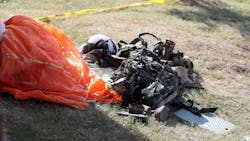Dramatic Video Shows Navy Jet Crashing Near Fort Worth in 2021 After Bird Hits Engine
The Navy trainer jet that crashed into a Lake Worth neighborhood during a landing approach last September was downed by a large bird, according to military documents and cockpit video obtained Tuesday by the Star-Telegram.
A 4.5-pound black vulture was ingested into the jet’s single engine as it descended toward a runway at Naval Air Station Joint Reserve Base Fort Worth, according to a Navy report. Within 30 seconds, the jet plummeted into backyards and burst into flames, injuring at least three residents.
A military instructor and a student pilot, who were on a training flight from Corpus Christi, ejected just seconds before impact and suffered injuries. The accident caused nearly $47 million in damage, including medical costs and the destruction of the plane, according to the report.
A Star-Telegram investigation published in the weeks after the crash found that the Lake Worth neighborhood lies within an “accident potential zone,” meaning that the federal government has designated the area as higher risk for plane crashes because of its proximity to the base.
But since the crash nearly one year ago, it has been unclear what caused the plane to go down.
In the flight video, which was obtained by the Star-Telegram through a public records request, the plane appears to be operating normally until the final minute before the crash. The Navy report describes the majority of the flight as “uneventful.”
As the jet approaches the runway and descends, a bird appears in the distance.
One bird passes to the right in the video, followed by a second bird. A third bird appears and passes to the left. And then, a fourth bird appears directly in front of the plane. As it comes into focus, the feathers on its wings are visible as it tumbles to the lower right side of the video frame.
“Sh—!” one of the pilots yells.
Seconds later, alarms begin sounding in the cockpit, obscuring the pilot’s voice as he talks over the radio.
“Emergency, we are trying to make it to the runway,” he says. But as landing instructions come over the radio, about 20 seconds after the bird strike, the pilot interrupts.
“We’re not gonna make it,” he says. With alarms still sounding, the aircraft dips suddenly toward the ground, the trees below coming closer into view.
Six seconds before the crash, a pilot yells, “Stand by to eject. Pull up! Pull up!”
The last frame of the video shows the top of a tree, overlaid with a bright green arrow from the flight controls.
After ejecting from the plane, the instructor landed in a wooded area and was left with minor injuries, local police said at the time. The student pilot was caught in power lines. Eyewitnesses told the Star-Telegram that they saw the student catch on fire. Police said at the time that he was “badly burnt.”
The student survived. After about a month and a half in a Dallas-Fort Worth area hospital, he was transferred to a hospital in San Antonio.
The plane itself — a T-45C Goshawk — damaged several homes and came to rest in a backyard. A neighbor of that home told the Star-Telegram at the time that the yard was engulfed in flames; the fence gate was so hot he couldn’t touch it.
No civilians were killed or seriously injured in the crash, which neighbors and authorities have referred to as “a miracle.”
The Navy report categorized the crash as a “wildlife strike” event. Immediately after the plane ingested the bird, the report says, the engine compressor stalled. The report also noted that a “post-inspection of the aircraft revealed bird remains, including blood on the starboard intake, in the engine.”
While much of the report is redacted, a summary of the crash cost lists $250,000 in civilian property damage, $400,000 in environmental impact, $877,000 in federal injury costs and $45.4 million in federal property damage. In total, the crash came with a price tag of $46.93 million.
#zone-el-9 { display: none; } .story-body { padding-bottom: 30px; }
©2022 Fort Worth Star-Telegram. Visit star-telegram.com. Distributed by Tribune Content Agency, LLC.
